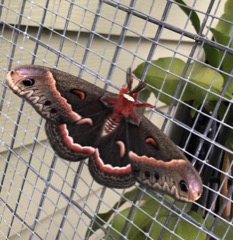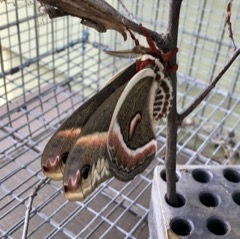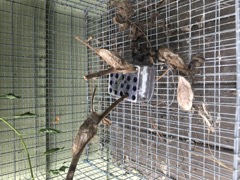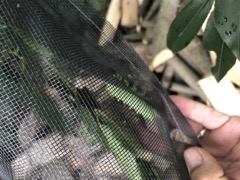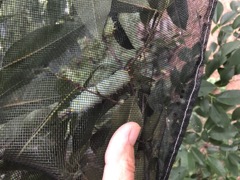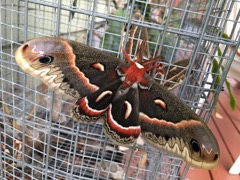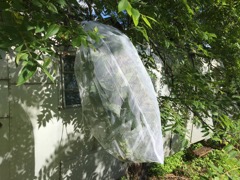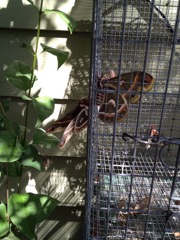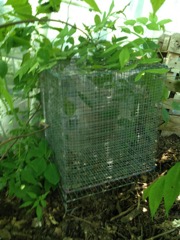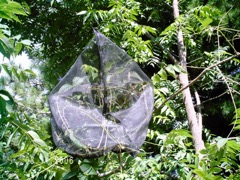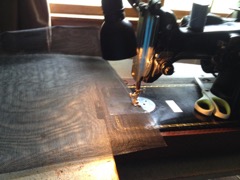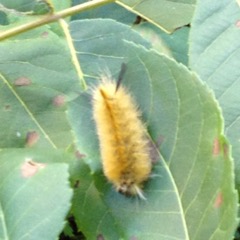People often ask why I raise these moths. This is why. I'm trying to do some little thing to offset other people mindlessly killing them, and other benificial insects, in their attempts to sterilize there lives.
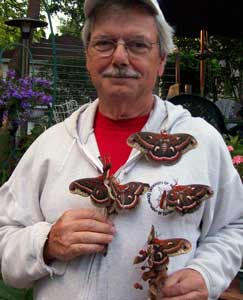
Moth Man
Moth Man.
For the past 22 years I have been raising Cecropia moths. It started with a favor for Phil Pellitteri (UW - Extension Entomologist) who asked me to 'baby sit' a caterpillar while he went out of town. Since then I have been fascinated with these elegant and beautiful creatures, how easy and fun it is to raise them, and how important it is to keep them from extinction. <read more >
FYI: Gypsy Moth Spray Notice for Wisconsin:
(this is important because some methods for suppression of Gypsy Moth also affect Cecropia Moth and timing is critical in these applications. )
-
"The DNR suppression program spraying is complete for 2016."
- Wisconsin Gypsy moth Site: http://gypsymoth.wi.gov
- Dane County web site http://www.countyofdane.com/lwrd/parks/gypsy_moth.aspx
- Department of Natural Resources web site: http://gypsymoth.wi.gov/.
Some web sites for Gypsy Moth information:
2023 Season: No Mating Pairs this year.
I always feel guilty holding on to these moths after they eclose and start fluttering around in the cage. I think that means their wings are dry and they are ready to fly and find a mate.
So when the first two males were out for a couple days I set them free. The problem was the remaining 5 moths turned out to be female. In the past, when I have done this, I believe the males returned for mating. This year they didn't -- and no 'wild' males were attracted -- so I have no eggs.
2022 Season: I have only three cocoons this year.
2021 Season: The second year that I have had no moths of my own.
Something went wrong with last year's cocoons
No, none of my cocoons had viable moths this year. I've never had this happen before. I don't know if I had them in the hot sun and they 'cooked' or something else happened.
Or maybe it was because they came from 2020 -- the year that wasn't ...
Luckily, I have friends who had plenty of eggs to share with me. Actually, too many so I shared some of them with a few other folks here in Madison, who were very happy to get them.
This was an early year. Many folks were telling me about their moths emerging and I kept waiting for mine; thinking they would be in the late batch -- but no.
I get by with a little help from my friends ...
Finding food for Cats on Cherry Tree
This spring I didn't have many Walnut trees in my back yard to host these caterpillars so I put them on a Black Cherry.
They soon finished off all the good ground level leaves so I had to do some climbing.
I just happened to have this wood pile handy under the Cherry tree.
2021 Time Line:
- Jun 11: Picked up 75 Ceceopia eggs that were laid on June 6.
- Jun 12: Gave most of these eggs away. I would get more.
- Jun 16: Eggs hatched. Placed cats on Black Cherry
- Note: I didn't get more eggs after all but that's okay.
2019 Season: (Yes, after 20 years I'm still doing this)
-
2019 spring was wet and cool in Madison. My moths were in no hurry to come out and I was getting a little worried when friends in Northern Wisconsin already had mating pairs in early May.
My first moth emerged June 8 and was severely deformed. I had to cut him out of his cocoon and he basically had no wings. Very sad. He was alive however and doing his best to emerge when we found him. He lived for a few weeks but pretty much just layed there.
The first healthy moth emerged a week later. This was the first of three male moths that emerged over the next few days. I don't like keeping moths very long,. After a couple days they are ready to fly and If I don't let them go they wear themselves out trying to get out of the cage.
since no female moths were coming out I released the male moths on June 25th.
Two days later the females began emerging. Buy June 28th I had three females and early that morning there were 3 male moths hanging on the outside of the cage. One was mating with a female on the inside. I carefully moved the other two males inside the cage.
There were a couple more male moths flitting around in the bushes. They seemed to know that all the females were taken and didn't try to approach the cage. They quickly flew away.
There was a fourth female this year. She seemed fine but I moved her to a separate cage so I could keep track of her. I think that cage may have over-heated in the sun (there was no wind). She has been pretty listless since and I think she's not going to make it. I won't use that cage anymore.
2019 highlights (from my cocoons located in Madison):
- June 8: First of my Cecropia emerged t- Male. Deformed
- June 16: 3 more Cecropia emerged - all Male - all healthy.
- June 25: First Female.
- June 28: First eggs.
- June 28: Released females to lay eggs in wild.
- June 30: Two remaining females have not mated for some reason.
- July 2:Third female FINALLY mated today. I wasn't sure she had it in her. She's been in the cage with a male for almost a week. I think she'll finish once it gets dark. (she's free to go anytime she likes).
2016 Season:
-
2016 was an extraordinarily early year for Cecropia moth emergence. My first moth in Madison Wisconsin eclosed on May 27, 2016.
This year was the first year that Kathy in Polk County Wisconsin had a mating pair that produced eggs. She got a bunch and she tried to raise them all. She was more successful than she dreamed and by the time they began to spin she was totally burned out.
My luck wasn't as good. I had a mating pair but I was traveling north to the farm in Polk County when the eggs hatched here in Madison. I'm afraid earwigs got all the young caterpillars. I knew this was a danger so I gave a couple dozen away before I left and took a dozen with me to the farm and put them on trees up there. This left me a little short so I Kathy was kind enough to give me some of hers.
New Bag
Kathy discovered a new system for bagging the caterpillars on the tree branches. She found mesh laundry bags at Walmart for only a couple dollars each (two for $7.77 ). These already have a draw string and there's no sewing required. (my old bags were made out of window screen and had to be sewn into a bag.) I don't know if the mesh is too big to keep out earwigs but these could certainly be used for caterpillars in the second instar onwards; when they're past danger from earwigs.
See Below for details on the use of mesh bags for raising caterpillars. <click here.>
- May 27: First of my Cecropia emerged t- Male.
- May 29: Second and third Cecropia emerged - both Male.
- May 30: First Female.
- May 31: First eggs.
- June 27: Last Moth emerged - female.
- July 31: First caterpillar spins cocoon. (Yes, that's July 31 -- incredible!!)
-
2015 Season:
This seems like a pretty normal season in Madison. The first wave of moths began emerging around May 19th - according to our local email list. It seemed like most folks had the early group around here. I only had one Male come out early - I let him go..
The remaining dozen or so cocoons that I had began popping 17 June 15 and continued to the last one on 26 June 15.
- May 30: First of my Cecropia emerged t- Male. This one escaped during the first night ???
- June 17: Second Cecropia emerged - Male.
- June 19: Three more Cecropia emerged - All Male.
- June 21: Released total of 5 male months since no females had emerged
- June 22: First two female Cecropia emerged.
- June 23 - Attracted male from outside and they mated through cage.
- June 24 - I forgot to check mating and she laid her eggs on the screening of the cage.
- June 25: - Second female attracted mate from the wild during the night . I had left the cage door open so this one could get in. I bagged these and collected the eggs. ( This batch of eggs never hatched - this is the first time this has happened in all the years I have been doing this.).
- June 26 - I left the cage door open from now on - I had enough eggs - so the remaining moths flew the coop as soon as they were ready.
- August 22- First Cecropia spins up.
- September 5 - Last Cecropia - on walnut - spins up. There was one runt that is still eating.
- September 8 - all apple caterpillars have spun cocoons.
- The first batch of eggs were attached to the cage wire so I placed the whole cage under a bushy walnut tree that I have in the back yard and draped some of the low branches on top of the cage. When the eggs hatched, all the new caterpillars went to the leaves and after a couple days I moved the cage away and bagged the branch.
- When the eggs hatched, all the new caterpillars went to the leaves and after a couple days I moved the cage away and bagged the branch.
- I believe that these new caterpillars line up in ranks to deter predators (like the earwigs). Once they get some size (second instar?) they spread out and find their own leaf/twig/branch.
- I was glad that these caterpillars were so obliging as to accept my diner invitation because the second batch of eggs didn't hatch. I have never had this happen but something must have gone wrong with that mating.
- I keep the Cecropia caterpillars in mesh screen bags on the branches of whichever nurse tree I choose (they will thrive on almost any tree species but they should be kept on the same species from hatching to spin-up).
- Notice that this bag is about ready to be moved to a new branch. (click on image to enlarge)
- Gather the open end around the branch and secure with a piece of twine or wire. I make this tight to keep out any predators outside, and to keep the fully grown caterpillars inside (when they are ready to spin they get a wanderlust).
- You can make these bags out of fiberglass window screen purchased at any hardware or big-box store. It comes in a variety of sizes but a nice size to begin with is the 36 X 84 inch roll.
- Lay this out lat and fold it in half.
- Cut along this fold to make two 42 X 36 inch pieces.
- Fold each piece in half along the 42 inch side to make a 21 X 36 inch rectangle.
- Then simply sew two of the adjacent cut edges together. This, along with the fold edge, forms the three sides of the bag leaving the remaining side open.
- This will produce a very manageable bag size; large enough to fit over a branch that is large enough to provide a few days food for a hand full of nearly mature caterpillars but not so big that it becomes unwieldy for one person to handle.
- I use the longest stitch setting on this old machine. Straight stitch with any medium or heavy thread.
- This year I saw a number of these Tussock Moth caterpillars on the Black Walnut nurse tree. This is the first year I've seen these guys. They feed on the walnut leaves and make their cocoon in the branches but do not attach it to the twigs; like the Cecropia. The finished cocoon falls the ground and over winters in the leaf litter under the tree.
2016 highlights (from my cocoons located in Madison):
2015 highlights (from my cocoons located in Madison):
Make a bag to keep the caterpillars (and to keep them safe) while they're eating.
( Click on pictures to enlarge - then use 'back' button in browser to return. )
2014 Season: This has been a wet spring. Some would say cool but it's probably been pretty normal over-all. Many people have reported 'early' emergence this year in this area. The first was May 30 in Middleton with first eggs flayed June 17. More evidence that there are two distinct flights of Cecropia Moths each season: the first in late may or early june, the second in late june and early july.
I am not familiar with the conditions under which these early reporters are raising their cocoons so I can't say if they are really 'naturalized'. They talk about having trouble drawing males from the wild and therefore are in-breading their pairs in order to get eggs. I take pains to keep my cocoons in as close to a natural environment as possible so that they will 'see' the same climate as their natural counterparts. This has helped keep my cocoons in sync with the wild cocoons in the area. But, of course, I can't say whether these wild individuals are really just siblings of my captive moths. And how much 'mixing' is there really in nature.
2014 highlights (from my cocoons located in Madison):
- June 14: First Cecropia emerged - Male.
- June 15: Second Cecropia emerged - Male.
- June 16: Third Cecropia emerged - Male.
- June 19: Released these three male months since no females had emerged
- June 20: First female Cecropia emerged.
- June 23: Two more female moths emerged (one is a runt). (Just as I was thinking that my remaining cocoons were no good and that for the first time in years I wouldn't have caterpillars to raise.)
- June 23 - released first female moth - no males have arrived either by wind or by emergence. This female had dried and was fluttering about so I let her go.
- June 25 - 4:30 AM Two male moths are at the cage, trying to get in. I put one inside but the other escapes and flies away. The male immediately mates with the runt female. No sign of the second mail and now it's probably getting too light or he has found another signal to chase. I've never seen them give up this easily.
- June 25: Two more moths emerged today - one male and one female.
- June 26: 'Visiting' male finished copulating with the runt and began with the "old" female. (i've wondered if they would do this or if the male would be spent after one mating).
- The new male and female are drying their wings but haven't joined up.
- No visitors this morning- I think the male had already moved to the female so she was probably not calling any more and the new female hasn't started producing pheromones (calling) yet.
- June 27: First eggs from 'wild' mating (actually runt was first but she turned out to have trouble laying her eggs - they came out in a couple small bunches.
- June 28: 6:00 AM another wild male arrived. I put him in the cage with the remaining two siblings (male and female) but nothing is happening yet. Strange since they usually join up right away when they're called.
2013 Season: This season has been the direct opposite of last year. It has been cold and wet until mid May. Our first really warm days occurring in early June.
This year we witnessed the emergence of a new moth. In 15 years of raising these mother, this is the first time we have seen this.
This video shows the first 10 minutes in real-time (I made a couple cuts later on in the video that totaled less than a minute).
Note - to whom I have given Cecropia:
Don't Panic!
July 1, 2013: For those of you to whom I have sent eggs do not panic. These eggs seem to be taking a long time to incubate - 10 days so far - but I have checked one and there are, in fact, embryos in this batch. They are just being pokey about hatching for some reason.
Spring 2013 has been very cold and wet in Wisconsin so you've probably already moved these cocoons from where ever you had them over-wintering (hopefully exposed to the cold weather) somewhere where they are exposed to the outside temperatures. Here is a reminder of what you should expect now.
Even thought it's been a cool spring (in Wisconsin) the moths should emerge sometime in June. When they do come out they will stay put for a day or so - not try to fly away - until they're wings are dry. If it's a female, she will be happy to stay close but a male will try desperately to get out as soon as he gets a whiff of the pheromone on the wind.
The female will attract a male to her and once mated (4-5 hour process) the female will fly away (if you let her). She will begin to lay her eggs within minutes of mating. The eggs will hatch within a week.
(she lays them in a very tough glue substance so keep this in mind when you decide where to keep her - I use a grocery bag).
Don't worry about what species of tree to place the eggs because the new hatchlings don't lock in on a particular species until they come out and eat a bit (the mother decides what they will eat by where she chooses to lay the eggs). She always seems to prefer some form of apple tree (even though my evidence says they grow faster on walnut.) I have yet to find a tree species they won't eat once they get started.
I hope this get's you going and I wish you all the luck in raising a new generation of these incredible creatures.
- Stuart
Subject: cecropia moth cocoon
Date: October 5, 2013 10:39:23 PM CDT
To: treenut2k@gmail.com
Greetings Stuart,
Perhaps you've heard of some strange places for cecropia moth's to spin their cocoons. I found one on the inside seam of a beautiful pair of blue flax slacks that I had washed by hand and hung out to dry .Several days later had a strange feeling when I put them on( and a moment of panic).Perhaps they like natural fabrics, and as the clothesline is under a willow tree in my backyard, can't blame the caterpillar.
Very fortunate to find the WPT garden show's episode of your interview, as I was worried about whether the cocoon was planning to emerge this fall or not. I have it hung on a willow branch with a clothespin for lack of any better ideas.Any comments?If they are stored in the garage is it just put into a baggie or hanging free?Do they need to be attached to a branch when they emerge in the spring?
When I took it outside to re-home it, it began to vibrate in my hand.hink its become a friend. Perhaps I could recruit more of them.
Wondering if you have any advice for me as I am an absolute novice. I live in the Waupaca area, and surrounded by mostly conservation area, near Hartman Creek State Park.Not too much spraying going on, hopefully.
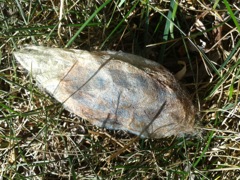
2013 highlights:
- First Cecropia (3 males) emerged June 17.
- First female Cecropia emerged June 19
- Second female and 4th male emerge June 20
- released 2 male Cecropia evening June 20. They were anxious to leave so I think they were being called.
- Remaining 2 pairs mated June 21. I bagged one pair in order to save eggs.
- Released one of the mated females and all remaining males June 22.
- June 24: Three more females have emerged (see video above) but no males have been drawn in from the wild. Hopefully these girls won't become old maids.
- June 29: All the girls have either left or died. I'm afraid all were old maids - no males were to be found. Eggs have not hatched yet - should be any day now.
- July 4, 2013: The eggs have finally hatched. I don't know why it took so long this year but I have a ton of little critters and now I don't know what to do with them all. I'll raise them through the first two instars - mostly on the black walnut in the back yard here in Madison - and then probably release most of them onto various walnut trees at the farm in Centuria.
- No Promethia this year. I have about 8 promethia cocoons and as of July 19 none have emerged. The latest year that I've seen before this was July 15, 2010. I still haven't given up completely.
2012 Season: This spring we had an incredibly warm March in Madison Wisconsin, followed by a normal April (that felt cold in comparison). Perhaps this will cause things to happen sooner. The early part of the summer has been very hot and dry.
2012 highlights:
- First Cecropia (female) emerged May 28.
- First Promethia (female) emerged May 28.
- First Cecropia cocoon on July 24, 2012 (earliest ever by nearly one month)!!!
2011 Season: I can tell every time the Wisconsin Gardner episode aires because I get an influx of emails requesting moths. This is great and I am trying hard to fill all 'orders'.
2011 highlights:
- Cool spring but still seems moths began emerging early (both Cecropia and Promethia moths.)
- First Cecropia's (two males) emerged June 2d and third. Released both because I didn't yet have a female.
- First Promethia emerged on June 5th. Male arrived from the wild at dinner time on June 7th.
- Two Cecropia females emerged during cold and rainy period after I'd already released the early males. No males were drawn in and the female's eventually died.
- My last two Cecropia to emerge were male and female. On June 30th another male was drawn in from the wild and one of the males mated with female. I had bagged all three so that this time she wouldn't escape before laying me some eggs. She laid over a hundred and I let all three moths go.
2010 Season: Getting some good feedback, and questions, from this web site. THANKS!
2010 highlights:
- Very warm spring with relatively early emergence of Cecropia and Prometheus moths.
- My only female Cecropia 'flew the coop' before I could get any eggs. Will this be the first year I don't raise Cecropia?
- Saved by a friend, I have Cecropia AND Promethia eggs once again.
- Promethia eggs laid on 16 June AND a female prometheus moth who emerged on 1 July attracted 3 male moths from the wild. Evidence that they don't all come out at the same time(?).
2009 Season: hard to believe I've been doing this for 10 years....
2009 highlights:
- Cool spring with relatively late emergence of Cecropia and Prometheus moths.
- Segment on WPT's Wisconsin Gardner with Shelley Ryan to be aired 23 July 2009 at 7:30 PM on Wisconsin Public Television. "... strikingly beautiful and cause no harm to the garden." (Shelly's referring to the moth larvae - not me.)
- First year I've had a Prometheus moth mate and lay eggs (complete full life cycle).
- Oh, the humanity!!! (moth-anity?). Larvae population decimated by (???)
Click here to view 'early years' web site (1999 through 2002)
Resources:
Contact me at email link at bottom of page if you have questions, need eggs, or would just like to chat about raising moths.
- UW Entomology Insect Diagnostics Lab. Phil Pellitteri.
- Quick 'pocket' guide to raising Cecropia - Dr. Paul William's describes how to apply Bottle Biology techniques to raise moths.
- "When Biologic Control Gets Out of Control" - NY Times article.
- "The Wild Silk Moths of North America" - Book about this moth family (Saturniidae)
